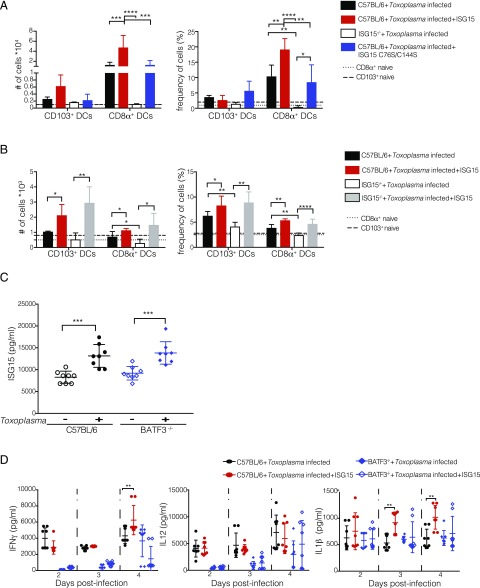FIGURE 5.
Free ISG15 increases IL-1β–producing CD8α+ DCs at the site of infection. (A) C57BL/6 and ISG15−/− mice were infected with 2.5 × 104 Toxoplasma tachyzoites i.p. C57BL/6 mice were either infected only or infected and treated with recombinant ISG15 or with ISG15-C76S/C144S mutant. At day 4 p.i., cells were isolated from the peritoneal exudate and FACS analysis was performed. CD8α+ and CD103+ DCs total cell numbers and cell frequency as percentage of total are shown. Three mice per group, one of four independent experiments. (B) C57BL/6 and ISG15−/− mice were infected with 2.5 × 104 Toxoplasma tachyzoites i.p. Mice were either infected only or infected and treated with recombinant ISG15. At day 4 p.i., cells were isolated from the spleen, and FACS analysis was performed. CD8α+ and CD103+ DC total cell number and cell frequency as percentage of total are shown. Three mice per group, one of two independent experiments. (C) C57BL/6 and BATF3−/− mice were either uninfected or infected with 2.5 × 104 Toxoplasma type II tachyzoites Prugniaud (Pru), and serum ISG15 levels were assessed at day 4 p.i. (D) C57BL/6 and BATF3−/− mice were either infected only with 2.5 × 104 Toxoplasma type II tachyzoites Pru or infected and treated with recombinant ISG15 (1 μg/mouse) at days 0, 1, and 2 p.i., and ELISA for IFN-γ, IL-12, and IL-1β was performed on serum samples collected at different time points. Data combined from two independent experiments. Each individual point corresponds to a separate mouse (C and D). One-way ANOVA statistical analysis with Tukey test of Toxoplasma-infected versus naive mice, ***p < 0.0005 (C). Two-way ANOVA statistical analysis with Tukey test of Toxoplasma-infected and Toxoplasma-infected plus recombinant ISG15–treated mice (A, B, and D). Only statistically significant relationships are shown. *p < 0.05, **p < 0.005, ***p < 0.0005, ****p < 0.00005.

